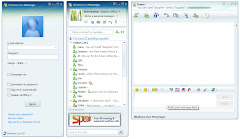
Sunday, August 31, 2008
Contrast between Defoe and Swift

Friday, August 29, 2008
Beowulf: Poem vs. Film (by Martín Gómez)

Have you already assumed that films based on books are rarely loyal to the original pieces? I bet you had. But even expecting Robert Zemeckis' Beowulf movie not to be the exception wouldn't do much to prevent you from horrifying at the finding of such a butchery as can be seen in the epic poem 21st century Hollywood version.
Let's just put three major points into consideration:
1. Epic poems main characteristic is the presence of a hero. If you've read the book, you probably got a good idea of how an epic hero of around the 10th century was to behave... Now, what's so heroic about a man who - because of weakness - conceives his own assassination with the monster whose child is killing every 'good guy' around? That doesn't sound like good old Beowulf...
2. The same goes for the respected King Rothgar. In the movie, he's said to have been through the same situation than Beowulf's, conceiving a menace with exactly the same monster years ago! How ironic; heroes were supposed to be extremely difficult to kill, and now somebody has managed to destroy two of them in ten minutes of film...
3. Remember Grendel? That awful, bloody demon which terrified Rothgar's kingdom? And do you remember Grendel's mother? Probably twice as fierce and awful than her son? Well, 2008 Hollywood Grendel's mother is... Angelina Jolie! I don't know you, but I don't think words such as 'monstrosity' and 'Angelina Jolie' can be placed in a same sentence without breaking any moral rule...
Perhaps we should be open-minded and expect remakes to be more like reinterpretations? After all, it seems interesting to see how different societies reinterpret classics such as Beowulf across time, through completely different viewpoints...
PS: if you still want to see the film, I've got a copy at home ready to be lent. It's got a really neat animation!
PS2: Beowulf's not there, though...
Thursday, August 28, 2008
Literacy and Cognition (by Ronaldo Rodríguez)
The capacity to decode and encode symbols which is usually referred to as literacy has been object of analysis and study beginning with the Greek civilization. Among the principal arguments raised since their time, the “Great Divide” theory, which claims that literacy causes dramatic changes in individuals’ cognitive development, seems to be not only one of the strongest contentions but also the most widely accepted among scholars.
In 1963, “The Consequences of Literacy” by Goody and
Opposition to the “Great Divide” theory, however, has emerged in modern times. Olson (1996), for instance, considered that the analysis of literacy and cognition was unable to specified how exactly one influences the other. The “Great Leap” theory has also been said to be ethnocentric (Heath, 1983; Scribner and Cole, 1981) for it does not seem to account for the development of societies out of the western world.
Tuesday, August 5, 2008
Photo of a cannibal?

The students
- Daniela Duhalde
- Jésica López
- Jésica Pereyra
- Néstor Cevasco
- Cecilia Weiman
- Daniela Duhalde
- Andrea Mariño
- Flavia Lassati
- Jésica López
- Jésica Pereyra
- Mariana Genise
- Marisol Mallemaci
- Martín Leardi
- Roberto Quinteros
- Susana Guaglianone
- Vanesa Aguglia
- Cecilia Acosta
- Paola Ríos
- Sandra Martínez
- Yanina Helvig
- Cecilia Acosta
- Flavia Lassati
- Néstor Cevasco
- Paola Ríos
- Ruth Castillo
- Susana Guaglianone
- Vanesa Aguglia
- Verónica Mateos
- Yanina Helvig
- Cristina Hoppenthal
- Griselda Zagari
- Hernán Ruiz
- Karina Schiaffino
- Martín Gómez
- Paola Oksa
- Ronaldo Rodríguez
- Valeria Juárez
- Cecilia Navarro
- Cristina Hoppenthal
- Edith Romero
- Hernán Ruiz
- Karina Schiaffino
- Martín Gómez
- Octavia Dávalos
- Ronaldo Rodríguez
- Romina Goncalvez
The teacher

Selected papers
►Gospel principles taught in Robinson Crusoe (Ronaldo Rodríguez)Read or download here.►Presence of European ships in Robinson Crusoe (Cristina Hoppenthal)Read or download here.►Analysis and Comparison between the poems ‘The Divine Image’ and ‘The Human Abstract’ from William Blake’s ‘Songs of Innocence’ and ‘Songs of Experience’ (Cristina Hoppenthal)Read or download here.
►"Did he who made the lamb made thee?" (Ronaldo Rodríguez)
Read or download here.►'Holy Thursday' from Songs of Innocence and Songs of Experience (Martín Gómez)
Read or download here.
Assignments (L&C IV)
Read or download here.
►First assignment: Asterix in Britain through A Poetics of Postmodernism.
Read or download here.
Read or download here.
Read or download here.
Assignments (L&C III)
Read or download here.
►1st Assignment: Historiography through South Park.
About us
About the subject
El espacio curricular Lengua y Cultura se conforma como parte de la currícula del Profesorado de Inglés, teniendo como objeto de estudio los principales procesos socio-culturales y geopolíticos del mundo occidental, con particular atención por el rol de las naciones anglosajonas, aunque sin perder de vista el efecto de estos procesos sobre la coyuntura internacional en su conjunto, y sobre el ámbito argentino y latinoamericano en particular.
Este espacio curricular se articula en cuatro niveles, cada uno de los cuales centra su atención sobre un espacio de tiempo específico:
- Lengua y Cultura I: el mundo contemporáneo
- Lengua y Cultura II: el siglo XX
- Lengua y Cultura III: el período de consolidación de la modernidad
- Lengua y Cultura IV: la antigüedad, Edad Media y Renacimiento
Se entiende que el fin último de esta perspectiva debería ser aspirar a la conformación del futuro docente como un sujeto históricamente constituido, consciente de su rol en una sociedad determinada física y temporalmente, y capaz de disponer de manera crítica de los instrumentos intelectuales heredados y de reflexionar sobre el pasado y el presente como camino hacia la construcción del futuro.



